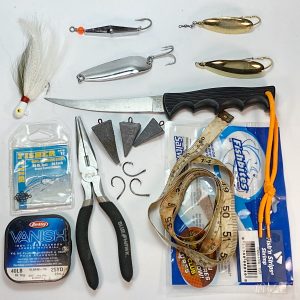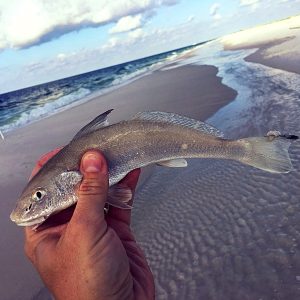Some might wonder why anyone would try to catch ladyfish on purpose. They are, after all, commonly known to be a “trash fish”. Well, ladyfish fight hard, they often leap out of the water when hooked, and they are fairly easy to catch. So, if it’s a sporting fish you’re after, ladyfish are a good species to target.
Besides being a blast to catch, ladyfish are also great bait for larger species, such as sharks, bull reds, tarpon, snook, and others. The reason I usually target them is for shark bait.
So, if you’d like to hook in to some poor man’s tarpon, follow along, and I’ll tell you how.

About Ladyfish
Before we learn how to catch ladyfish, let’s learn a little about them. If you don’t care to read about general ladyfish info, just skip ahead to the next sections on how to find and catch them.
Ladyfish may be called different things in different regions. Where I fish, along the Florida panhandle, they are often referred to as “skipjack”. They also bear the nickname, “poor man’s tarpon”. Not only do they bear a visual resemblance to tarpon, but they also share their epic leaping abilities.
Ladyfish are a long, slender fish, maxing out around 3 feet long and about 5 pounds. They have small but sharp teeth, that can cut through lighter lines.
Although they can become quite a nuisance, at times, when you are trying to target other species, ladyfish are a great time for kids, tourists and anyone else just looking to get their lines tight. In fact, much like the feisty bluegill is a perfect freshwater intro, ladyfish fit the bill nicely for a proper saltwater fishing introduction.
Ladyfish are actually some of the first fish I encountered when I started fishing coastal waters many years ago. I was cutting my teeth under the Perdido Pass bridge in Orange Beach, AL, when something kept grabbing my live bait, stripping drag off my little red abu reel, and then ultimately cutting me off.
Only after 2 trips to a nearby bait shop did I finally dial things in with a 30 pound mono leader. Then, I started catching them, one after another. To this day, that was some of the largest ladyfish I still have ever seen. That experience is what hooked me on saltwater fishing.
- Aggressive biting fish
- Hard fighting, leaping, fun fish to catch
- Easy to catch
- Great bait for sharks, redfish, tarpon, among others
To Catch Ladyfish, You Have To Find Ladyfish
You can find plenty of ladyfish off piers, along beaches, and in the bays. They are also tolerant of low salinity waters, so you can sometimes catch ladyfish from inshore waters as well. My preference is to cast for them in the surf. That way, you also have an opportunity at all manner of fast swimming species.
You can pretty much catch ladyfish at any time of year in many places, certainly spring through fall. If you are having trouble catching ladyfish, they are probably just not there, so you need to move. Or, if you are on the beach, just wait, as they will likely pass through eventually.
As mentioned, ladyfish can handle fluctuations in salinity, so you can find them inside canals and bays. However, they most commonly run the beaches in schools, so when you catch one you can usually hook more in short order.
One great way to find ladyfish along Gulf Coast beaches is to watch for birds working the surface. Oftentimes that means a swarm of game fish are chasing bait, and that swarm is often made up of ladyfish. It could also be be a school of Spanish mackerel instead of ladyfish, but that’s ok, they would be an even better catch. At times, Spanish and ladyfish will even be mixed in together. Since they both pretty much eat the same things, they will hit the same offerings. It’s a win/win for us.
How To Target And Catch Ladyfish
Ladyfish can be caught at any time of day, and at any tide. My recommendation is to head to an ocean facing pier or beach and start throwing baits that imitate small silvery fish (more about the best baits below). Watch for birds working, or schools of fish busting the surface. Immediately move toward that action and chunk your bait on the outskirts of the action. You will most certainly hook up.
After you have located a school of ladyfish, getting bites is generally pretty easy. Keeping them buttoned up all the way to shore, or boat, however can sometimes prove difficult. They are quite good at thrashing around and working a lure free from their toothy mouths. To help with this, you can use a monofilament main line which will have some give, or at least use a mono leader.
I also frequently catch ladyfish while targeting pompano, whiting, or Spanish mackerel in the surf. They readily hit most baits that I put on my double hook pomp rig, as well as pretty much any lures I’m throwing for Spanish.
If specifically targeting ladyfish, you will want to use a heavy mono leader. If you run into some big ladyfish, they can cut through light mono pretty easily.
After you catch a ladyfish, they can usually be easily controlled by grasping their slender bodies by hand just behind the head. Definitely don’t try to lip it! They have a nice set of small sharp teeth that won’t feel good.
Best Baits Used To Catch Ladyfish
Ladyfish will eat all sorts of baits and lures, particularly those that mimic small silvery fish. Live shrimp, cut bait, hair jigs, spoons, jerkbaits, bubble rigs, and Mirrodines all work great.
When specifically targeting ladyfish, I don’t typically use live baits. Instead, I opt for lures that I can cast a long ways. Usually, when targeting schools of ladyfish, the action is so fast and furious, that constantly re-baiting isn’t necessary.
Ladyfish eat the same sorts of things as Spanish mackerel eat. Therefore, most of the same stuff you would use for Spanish mackerel will work just fine for ladyfish. Also, like Spanish, ladyfish like fast moving presentations. So, don’t be shy about reeling fast.

By-Catches When Targeting Ladyfish
When targeting ladyfish, you will undoubtedly encounter other surf dwelling species. The species listed below are just a few of the likely by-catches you will pull in when targeting ladyfish. That’s good though, as all these are fun to catch as well.
- Spanish Mackerel
- Hardtails (Blue Runners)
- Bluefish
Tackle To Use When Trying To Catch Ladyfish
You don’t have to get real picky with your rod and reel choice when trying to catch ladyfish. Whatever castable saltwater tackle you already have should be fine. However, if I have my preference, I’m targeting them from the beach with a 1500-5000 size spinning reel, attached to a 7-9 foot rod with a fast tip. I like a long rod so that I can reach way out to connect to passing schools.
Ladyfish do have good eyesight, so I would stick to mono or flouro leader material. Clear monfilament main line is ideal because it is almost invisible, and it stretches, which is helpful when ladyfish are jumping about at the end of your line. But, really, whatever main line you already have spooled up should work, as long as you have a clear leader strong enough to withstand the abrasion of a ladyfish’s sharp teeth.
You mainline can be as light at 10 pound mono and on up. I usually prefer 12-15 pound mono main line with about 1-2 feet of 30 pound mono leader.
There are a couple things you might want to consider doing when specifically targeting ladyfish. First, I would suggest bending down the barbs of your hooks, so as to limit damage to a fish’s mouth that you intend to release. Secondly, you might like to replace any treble hooks with single hooks.
Bent down barbs won’t drastically increase your loss rate, as long as you keep the line tight during the fight. And, when it comes to treble hooks, not only are single hooks easier on the fish, they could be easier on your own body parts if a thrashing ladyfish sends a hook flying your way.
Make sure you have some pliers, because sometimes it can be difficult to get the hook out. Also, you don’t want your hands near a thrashing fish’s mouth when treble hooks are hanging out of it.
Table Fare
In short, ladyfish are NOT great to eat. There are lots of videos online where people have tried a catch and cook them. Watch some of those, and come up with your own conclusion. Ladyfish have lots of bones, the texture isn’t good, and the taste tests certainly weren’t promising enough for me to even give them a try. There are so many better options out there for the dinner table, so I always throw them back, or keep them for bait.
Conclusion
Besides the fact that ladyfish make excellent cut bait for larger species, such as bull reds and sharks, they are also extremely fun to catch. Next time you find yourself headed to the beach, pack a rod and reel, some basic gear, and see for yourself how fun it is to catch ladyfish, one after another. Be careful though, they are like a gateway drug that gets you hooked on surf fishing. It’s truly a blast!
Here’s a couple other articles to show you how to target 2 more sporty fish that can be caught right from the waters’ edge.
How To Catch Pompano From The Beach
How To Catch Spanish Mackerel From Shore
Good luck!
Augustus Clay



